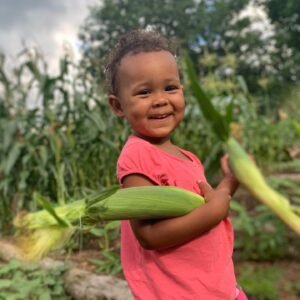Kids Gardening...Strengthening Your Child's At-Home Learning Experience
Gardening with Kids
My garden helper
One of the greatest joys of my life has been and continues to be, gardening with children. Their excitement and joy of working alongside you is rewarding enough to keep on gardening with them, but the benefits of getting them in the garden go much deeper. And with children spending more time at home, this is a great way to engage their minds in new ways, while also enriching what they already know. Think math, literature, art, history, nutrition, and of course, science- all can be learned through the garden! Here are some tips for interacting with the garden with these subjects in mind.
Math
Estimation- Pick a flower. Ask your child to estimate how many petals are on that flower. Then have them count them out. See if they can figure out the difference between their guess and the actual number. Multiplication- Beans- Ask your child to count the number of beans on one bean plant. Then have them count the number of plants in the garden. Ask them how they might guess how many beans they have and guide them through multiplication. You can also do this with other groupings of plants. If they are further along with their multiplication tables, you can do this exercise with smaller trees.
Art
Fairy gardens- Children tend to gravitate towards fairies and things mystical. Help them create a fairy garden. There are many images and ideas online. Show them some images and then encourage them to look around their yard, or local park, to look for those items. Have them create a fairy garden dwelling or neighborhood. (Note: Fairy gardens can be created in pots, balconies, cooking trays- no garden or yard needed). Some simple ideas are to use mulch pieces, or sticks, to make a fence. Flat rocks can be used for a patio and paths. And acorn caps make great fairy hats! Have them sketch or draw what the inside of the fairy house might look like, including what furniture the fairies have.
Literature
Storytelling- Now that the child has created a fairy garden, have them create a story about the fairies. Where did they come from? What do they like to eat? Who are their family members? They can also illustrate this story based on what they created in the yard, garden or elsewhere.
History
Research & Writing- All of the plants around us have a story to tell. And most, if not all, of them have had countless stories told about them. Have a child pick a meal or particular food they like to eat. Have them research the origin of that meal and/or the ingredients that make up that meal. They may like pizza, in which case they can trace pizza back to its origins, and also research the various ingredients used. Or, they may pick peanut butter and jelly...the options are almost limitless! You might also tell them a little bit about their heritage and what their ancestors used to eat.
Nutrition
Kids usually grow the food they eat. I can't tell you how many parents came to me after their kids started our gardening program and said that they are eating way more vegetables than they thought was possible. If I child grows a tomato, they will likely eat that tomato when it's ready. Gardening connects children directly to their food. They gain confidence and satisfaction in contributing to their meals. Have your child research their favorite fruit or vegetable. What vitamins does it have? How does that vitamin support our body? How much of that vitamin does our body need. You may also have them discover the nutrition of the meal that they researched in the previous exercise.
Science
Photosynthesis! Many of the other activities mentioned naturally also touch on science. Science is everywhere in the natural world! But an awesome place to start is what do plants need to grow. What do plants eat? How do nutrients move through a plant's body? How is that different or similar to how nutrients, oxygen, CO2, and water move through our bodies? Other tips! Plant quick ripening, easy-to-pick, no-cook plants in areas where they like to play. Cherry tomatoes and ground cherries are two of our favorites and can be grown in pots. Also, radishes and carrots are a favorite! It is super exciting to pull up a root and eat it.Share in the bounty together, even if it is just your luscious, delicious potted cherry tomato plant! They will gain confidence seeing you enjoy the fruits of their labor. If you are able to have a garden, make a kid gardening zone. Let them pick what they want to plant. Make the physical boundaries clear. My daughter has her zone. She learns consequences and respect based on the decisions she makes about her garden space. There are countless gardening with kids resources online, and some good books, too! Some should be available at your local library. Our favorite books are Roots, Shoots, Buckets & Boots, by Sharon Lovejoy, and A Kid's Herb Book for Children of All Ages, by Lesley Tierra and From Seed to Plant, by Gail Gibbons. I have over 12 years of gardening experience working in over 15 elementary schools, 1 preschool, and 1 middle school, connecting core curriculum to the outdoors. Please feel free to ask questions!


